#urban heat island
Text
youtube
PBS Member Stations rely on viewers like you. To support your local station, go to: http://to.pbs.org/DonateTerra.
With extreme heat waves in Europe, Asia, the United States and beyond, it’s clear climate change is making summers more dangerous and deadly. Urban areas are feeling the worst effects; a phenomenon known as the urban heat island effect. 2022 saw high temperatures in Kansas, Spain, Portugal, England (especially London), and India. But even within cities, the warming is not distributed evenly. During the Pacific Northwest heat dome of 2021, the region's most extreme heat wave ever, this temperature difference reached a staggering 25°F between neighborhoods in Portland, OR. And new research is illuminating how a century of racist housing policies known as redlining have contributed to this often deadly inequality.
The 2022 heat waves are not single events. They are another data point during years of escalating extreme weather. Previously, the 2019 European heat wave, the 1980 US heat wave, 1995 Chicago heat wave and many more are part of this trend.
In this episode we are going to dive into this unjust history of housing discrimination and see what it can teach us about how to keep cities cooler and save lives. We’ll visit Richmond, Virginia and Portland, Oregon to understand the problem and solutions. Innovative solutions are being carried out at the Science Museum of Virginia and by the Portland organization, Friends of Trees.
Weathered is a show hosted by weather expert Maiya May and produced by Balance Media that helps explain the most common natural disasters, what causes them, how they’re changing, and what we can do to prepare.
Subscribe to PBS Terra so you never miss an episode! https://bit.ly/3mOfd77
And keep up with Weathered and PBS Terra on:
Facebook: https://www.facebook.com/PBSDigitalSt...
Twitter: https://twitter.com/pbsds
Instagram: https://www.instagram.com/pbsds
#pbs Terra#solarpunk#heat islands#cities#heat wave#global heating#global warming#climate chaos#climate crisis#climate change#urban areas#urban heat#urban heat island#heat island effect#Maiya May#Youtube
3 notes
·
View notes
Text
"With “green corridors” that mimic the natural forest, the Colombian city is driving down temperatures — and could become five degrees cooler over the next few decades.
In the face of a rapidly heating planet, the City of Eternal Spring — nicknamed so thanks to its year-round temperate climate — has found a way to keep its cool.
Previously, Medellín had undergone years of rapid urban expansion, which led to a severe urban heat island effect — raising temperatures in the city to significantly higher than in the surrounding suburban and rural areas. Roads and other concrete infrastructure absorb and maintain the sun’s heat for much longer than green infrastructure.
“Medellín grew at the expense of green spaces and vegetation,” says Pilar Vargas, a forest engineer working for City Hall. “We built and built and built. There wasn’t a lot of thought about the impact on the climate. It became obvious that had to change.”
Efforts began in 2016 under Medellín’s then mayor, Federico Gutiérrez (who, after completing one term in 2019, was re-elected at the end of 2023). The city launched a new approach to its urban development — one that focused on people and plants.
The $16.3 million initiative led to the creation of 30 Green Corridors along the city’s roads and waterways, improving or producing more than 70 hectares of green space, which includes 20 kilometers of shaded routes with cycle lanes and pedestrian paths.
These plant and tree-filled spaces — which connect all sorts of green areas such as the curb strips, squares, parks, vertical gardens, sidewalks, and even some of the seven hills that surround the city — produce fresh, cooling air in the face of urban heat. The corridors are also designed to mimic a natural forest with levels of low, medium and high plants, including native and tropical plants, bamboo grasses and palm trees.
Heat-trapping infrastructure like metro stations and bridges has also been greened as part of the project and government buildings have been adorned with green roofs and vertical gardens to beat the heat. The first of those was installed at Medellín’s City Hall, where nearly 100,000 plants and 12 species span the 1,810 square meter surface.
“It’s like urban acupuncture,” says Paula Zapata, advisor for Medellín at C40 Cities, a global network of about 100 of the world’s leading mayors. “The city is making these small interventions that together act to make a big impact.”
At the launch of the project, 120,000 individual plants and 12,500 trees were added to roads and parks across the city. By 2021, the figure had reached 2.5 million plants and 880,000 trees. Each has been carefully chosen to maximize their impact.
“The technical team thought a lot about the species used. They selected endemic ones that have a functional use,” explains Zapata.
The 72 species of plants and trees selected provide food for wildlife, help biodiversity to spread and fight air pollution. A study, for example, identified Mangifera indica as the best among six plant species found in Medellín at absorbing PM2.5 pollution — particulate matter that can cause asthma, bronchitis and heart disease — and surviving in polluted areas due to its “biochemical and biological mechanisms.”
And the urban planting continues to this day.
The groundwork is carried out by 150 citizen-gardeners like Pineda, who come from disadvantaged and minority backgrounds, with the support of 15 specialized forest engineers. Pineda is now the leader of a team of seven other gardeners who attend to corridors all across the city, shifting depending on the current priorities...
“I’m completely in favor of the corridors,” says [Victoria Perez, another citizen-gardener], who grew up in a poor suburb in the city of 2.5 million people. “It really improves the quality of life here.”
Wilmar Jesus, a 48-year-old Afro-Colombian farmer on his first day of the job, is pleased about the project’s possibilities for his own future. “I want to learn more and become better,” he says. “This gives me the opportunity to advance myself.”
The project’s wider impacts are like a breath of fresh air. Medellín’s temperatures fell by 2°C in the first three years of the program, and officials expect a further decrease of 4 to 5C over the next few decades, even taking into account climate change. In turn, City Hall says this will minimize the need for energy-intensive air conditioning...
In addition, the project has had a significant impact on air pollution. Between 2016 and 2019, the level of PM2.5 fell significantly, and in turn the city’s morbidity rate from acute respiratory infections decreased from 159.8 to 95.3 per 1,000 people [Note: That means the city's rate of people getting sick with lung/throat/respiratory infections.]
There’s also been a 34.6 percent rise in cycling in the city, likely due to the new bike paths built for the project, and biodiversity studies show that wildlife is coming back — one sample of five Green Corridors identified 30 different species of butterfly.
Other cities are already taking note. Bogotá and Barranquilla have adopted similar plans, among other Colombian cities, and last year São Paulo, Brazil, the largest city in South America, began expanding its corridors after launching them in 2022.
“For sure, Green Corridors could work in many other places,” says Zapata."
-via Reasons to Be Cheerful, March 4, 2024
#colombia#brazil#urban#urban landscape#urban planning#cities#civil engineering#green architecture#green spaces#urban heat#urban heat island effect#weather#meteorology#global warming#climate change#climate hope#climate optimism#climate emergency#climate action#environment#environmental news#city architecture#bicycling#native plants#biodiversity#good news#hope#solarpunk#ecopunk#hopepunk
16K notes
·
View notes
Text
S.O.S. Earth: The tipping point of no return
Earth is at a critical juncture, with wildfires, floods, and record heatwaves signaling a climate in crisis. This isn’t a distant threat—it’s our current reality. The tipping point is here. Beyond this is no return. We need to take action now!
Climate change is no longer a distant threat lurking on the horizon—it’s here, reshaping our world in real-time. From devastating wildfires to unprecedented floods, the signs are clear and the time for action is now. As record temperatures scorch our cities and rising seas encroach on our coasts, we find ourselves facing a stark reality: the tipping point of no return is upon us. From the melting…

View On WordPress
#climate change#Debunking#intellect#melting glaciers#priyafied#reality#science#scientific illiteracy#SOS#temperature rise#urban heat island
0 notes
Text
#environment#human ecology#climate change#infrastructure#bbc#trees#urban heat island#urban heat island effect
0 notes
Text
Comparto el artículo “El efecto isla de calor: un desafió para las ciudades”, publicado en La Lupa el domingo 29 de octubre , 2023.
https://lalupa.mx/2023/10/29/el-efecto-isla-de-calor-un-desafio-para-las-ciudades-rodrigo-pantoja/

#architecture#arquitectura#mexico#mexicanarchitecture#climate change#urban heat island#isla de calor
1 note
·
View note
Text
And now the yes men are ready to pass climate lockdowns
#satellites give true air temp not "#urban heat #island"
hot in some #places not in others
#cold kills more than heat
they #overstate the effect so you downplay the #cost
#OneHealth'll grant #WHO(#BillGates its biggest funder)to impose climate #lockdowns
https://salvatoremercogliano.blogspot.com/2023/08/and-now-yes-men-are-ready-to-pass.html?spref=tw
#urban heat island#satellites#places#cold kills#overstate#downplay#one health#who#bill gates#climate lockdowns
0 notes
Text

Infrared satellite image from NWS Chicago on the morning of Sunday, November 20.
Labeled features on the map: A) warm (relatively) Lake Michigan B) relative warmth of urban heat island of Chicago metro area (more yellowish color) C) cold tops of lake effect cloudiness D) various larger rivers (warmer waters) E) Lake Geneva & Fox Lake (warmer waters)
Original link: https://mobile.twitter.com/NWSChicago/status/1594302868349399041
#lake michigan#infrared#infrared satellite#rivers#urban heat island#chicago#national weather service
1 note
·
View note
Text
Threat to “urban forests”
Threat to “urban forests”
What are the effects of trees in the city?
The urban environment exacerbates certain extreme climatic conditions and forms heat islands where temperatures are higher than those of neighboring countryside. Thanks to the process of transpiration, trees planted in the city act as a natural air conditioner that moderates this phenomenon. Trees also have a beneficial activity on the climate by…

View On WordPress
0 notes
Text

Memories of Autumn:
My favorite persimmon tree.
Memories necessary to escape the artificially intensified heat of summer, a result of living in a manmade island of concrete and asphalt and to ave something to look forward too.
One could say that autumn in Tokyo begins in November when leaves start changing colors. This may seem a month or two late, but one has to remember that Tokyo is southern area at about the same latitude as Winston-Salem, North Carolina or Athens, Greece. And, believe it or not, Las Vegas. (Tokyo is between 35-36 latitude north. Tokyo is not a city, it is a prefecture.)
Small Town Tokyo: Himonya
#tokyo#japan#photography#original photographers#photographers on tumblr#small town tokyo#persimmon trees#autumn#f**k summer#tokyo life#color photography#nature in tokyo#urban nature#urban photography#urban landscape#the only country where many believe is the only country with 4 seasons#the only country with four seasons#japanese myths#日本人論#synthetic city#concrete and asphalt#heat island effect#東京#日本#himonya#meguro
138 notes
·
View notes
Text
I can't remember if i posted this one before.
155 notes
·
View notes
Text
Umair Irfan at Vox:
It’s gearing up to be another scorching year.
Countries like Brazil, Thailand, Japan, Kenya, Nigeria, Australia, and Spain already experienced record warm temperatures this year, and in the past few days, heat has killed dozens in India and Mexico. Now states like California, Nevada, Arizona, and Texas are getting ready to roast as a massive heat wave settles in. It’s likely to push temperatures well into triple digits. And summer hasn't even officially started yet.
It’s an alarming echo of 2023, which was the hottest year on record, but this year could be hotter still. Though the Pacific Ocean is shifting into its La Niña phase, which typically brings cooler global weather, the extraordinary warmth over the past year is still baked in. Scientists say these record highs align with their expectations for climate change, and warn that more scorchers are coming.
There’s more to heat waves like this than high temperatures, though. The forces behind them are complex and changing. They’re a public health threat that can exacerbate inequality, cause infrastructure to collapse, and amplify other problems stemming from warming. But with global average temperatures continuing to rise, more records will fall.
Heat waves, explained
Extreme heat might not seem as dramatic as hurricanes or floods, but the National Weather Service has deemed it the deadliest weather phenomenon in the US over the past 30 years, on average.
What counts as a heat wave is typically defined relative to local weather conditions, with sustained temperatures in the 90th to 95th percentile of the average in a given area. So the threshold for a heat wave in Tucson is higher than the threshold in Seattle.
During the summer in the Northern Hemisphere, the northern half of the planet is tilted toward the sun, which increases daylight hours and warms the hemisphere. The impact of this additional exposure to solar radiation is cumulative, which is why temperatures generally peak weeks after the longest day of the year.
Amid the increase in temperatures in the summer, meteorology can push those numbers to extremes.
Heat waves typically begin with a high-pressure system (also known as an anticyclone), where atmospheric pressure above an area builds up. That creates a sinking column of air that compresses, heats up, and oftentimes dries out. The sinking air can act as a cap or heat dome, trapping the latent heat already absorbed by the landscape. The high-pressure system also pushes out cooler, fast-moving air currents and squeezes clouds away, which gives the sun an unobstructed line of sight to the ground.
The ground — soil, sand, concrete, and asphalt — then bakes in the sunlight, and in the long days and short nights of summer, heat energy quickly accumulates and temperatures rise.
Heat waves are especially common in areas that are already arid, like the desert Southwest, and at high altitudes where high-pressure systems readily form. Moisture in the ground can blunt the effects of heat, the way evaporating sweat can cool the body. But when there’s little water in the ground, in waterways, and in vegetation, there isn’t as much to soak up the heat besides the air itself.
[...]
But extreme heat can also build up in places that have a lot of moisture. In fact, for every degree Celsius the air warms (1.8 degrees Fahrenheit), it can absorb about 7 percent more water, which can create a dangerous combination of heat and humidity (more on that below).
Urban areas further exacerbate this warming. As roads, parking lots, and buildings cover natural landscapes, cities like Los Angeles and Dallas end up absorbing more heat than their surroundings and can become as much as 20°F warmer. This is a phenomenon known as the urban heat island effect.
Heat waves typically last around five days but can linger longer if the high-pressure system is locked in place. “In some cases, you actually can get these kinds of patterns getting stuck, and that can lead to heat waves lasting much longer,” said Karen McKinnon, an assistant professor of environment and sustainability at the University of California Los Angeles.
Eventually, the high-pressure system will start to weaken, allowing in cooler air and precipitation that can bring the heat wave to an end. However, as the warm season continues, more high-pressure systems can settle in and restart the heating process.
[...]
Climate change caused by greenhouse gases from burning fossil fuels is poised to make heat waves longer, more intense, and more frequent. It takes time for the dust to settle on the heat waves of a given moment, to allow scientists to evaluate just how much humans have contributed to the problem.
[...]
That heat isn’t distributed evenly, however. Nighttime temperatures are rising faster than daytime temperatures. “In general, since records began in 1895, summer overnight low temperatures are warming at a rate nearly twice as fast as afternoon high temperatures for the U.S. and the 10 warmest summer minimum temperatures have all occurred since 2002,” according to the National Oceanic and Atmospheric Administration. This can seriously impair how people cope with high heat.
The effects of warming can vary by latitude, too. Polar regions are warming up to three times as fast as the planetary average, fueling heat waves in the Arctic. In fact, cooler parts of the planet are heating up faster than places closer to the equator, so people living in temperate climates may experience some of the biggest increases in extreme heat events. Already hot parts of the world also get hotter, pushing them beyond the realm of habitability at certain times of the year.
And as human-generated greenhouse gas emissions continue to flood the atmosphere — atmospheric carbon dioxide concentrations recently peaked at 420 parts per million — heat waves are projected to become more frequent and more extreme.
[...]
The timing of heat waves is changing: Periods of extreme heat that occur early in the season tend to have greater public health impacts. That’s because people are less acclimated to heat in the spring and early summer. Cooling infrastructure may not be in place, and people may not be taking heat precautions like staying hydrated and avoiding the sun. That’s why early-season heat waves in the US, as we have seen across the country this year, are so troubling. As climate change makes heat waves more common, it also increases the frequency of early- and late-season extreme temperatures, lengthening the hot season.
The worst effects of heat aren’t always in the hottest places: While absolute temperatures may rise higher in already warm areas like the southwestern US, heat waves can have their deadliest impacts in cooler regions, where high temperatures are less common. Warmer areas often already have air conditioning in homes and offices, while regions that usually don’t get as warm have less cooling infrastructure and fewer places to find relief. The people in these regions are also less acclimated to high temperatures and may not recognize warning signs of heat-induced health problems.
Some people are far more vulnerable to extreme heat: Elderly people and very young children face some of the highest risks from extreme heat. People with certain health conditions, like high blood pressure and breathing difficulties, also face greater harm. But even otherwise healthy people can suffer from heat waves if they are exposed for long durations, such as those working outdoors in agriculture and construction.
Heat waves exacerbate structural inequalities: While cities can warm up faster than their surroundings, poorer neighborhoods — which are disproportionately home to people of color — tend to get hotter. These neighborhoods often have less tree cover and green spaces, and more paved surfaces that soak up heat. At the same time, lower-income residents may have a harder time affording crucial cooling. The pattern of heat inequality plays out on an international scale, too, with lower-income countries already facing higher health and economic costs from heat waves.
The tools used to cope with heat are also stressed by it: Power plants, which provide electricity for everything from fridges to air conditioners, themselves need to be cooled, and they become less efficient as the weather warms. Power lines have lower capacities under extreme heat, and hardware like transformers experience more failures. If enough stress builds up, the power grid can collapse just when people need cooling the most. Power disruptions then ripple through other infrastructure, like water sanitation, fuel pumps, and public transit.
We’re running out of time to act: All this means that heat waves are going to become an increasingly impactful and costly fact of life across the world — from the direct impacts on health to stresses on infrastructure.
But since humans share a significant portion of the blame for extreme heat waves, there are also actions people can take to mitigate them. Increasing energy efficiency can relieve stress on the power grid, and adding power sources that don’t require active cooling like wind and solar can boost capacity without adding greenhouse gas emissions.
Vox has a good article on why we are seeing longer and more severe heat waves around the world: climate change effects are part of the reason for the increased duration and severity of heat waves globally.
#Heat Waves#Extreme Weather#Climate Change#Weather#Urban Heat Island Effect#Greenhouse Gases#Extreme Heat
15 notes
·
View notes
Text
A new report looks at the hot spots of Atlanta's heat exposure
I like the looks of these recommendations from a recent report about Atlanta's heat risk. Cool roofing for low-rise buildings would be a great program for Atlanta!
As the effects of climate change produce hotter weather, it's important for us to find a way to benefit from the cooling power of urban trees while also adding affordable density in walkable formats near our transit lines.
Check out this map of heat exposure at the neighborhood level in Atlanta from the report. I'd love to see an interactive overlay of this with the satellite images:

I'll forgive this next slide for pegging the property between the Mercedes-Benz stadium & Georgia World Congress Center (GWCC) as a high density neighborhood -- no one lives here.
Focus instead on the potential for a cool roof on the giant, sprawling GWCC! That would be great.

This report was funded jointly by Council's Liliana Bakhtiari and Matt Westmoreland.
Here are the recommendations:
1. Increase total tree canopy across atlanta by about 350,000 trees (average of 1,400 per neighborhood). Tree investments should be prioritized in neighborhoods with a total vulnerability score of 8, 9, or 10. All trees added by the city should be positioned to shade impervious surfaces, which will also maximize benefits for stormwater runoff.
2. The results of this heat risk assessment directly support the city council's recently adopted goal of 50% tree canopy cover as a minimum for all neighborhoods. To achieve this level of tree canopy cover, policies for protecting existing canopy will need to be strengthened and complemented with new policies and programs designed to increase tree canopy cover and to replace trees in the public right of way when lost to extreme weather or disease.
3. We recommend cool roofing for all low-rise buildings (4 stories or less). Assuming an average roof area of 1,000 square feet, meeting this recommendation would require about 940 buildings/houses to be converted to cool roofs per neighborhood, on average.
4. The number of cooling centers for extreme heat events should be expanded and targeted to neighborhoods with the highest total vulnerability scores. All cooling centers should be equipped with backup power generation and the capacity to operate during an extended blackout period. The provision of water and ample recharging stations for communication devices can further enhance population resilience during extreme heat events. We recommend that a citywide heat surveillance system be deployed with a density of at least three weather stations per neighborhood with 2,000 residents or more and real-time public reporting of weather conditions. We further recommend that the city stablish a program to evaluate the performance of heat management investments over time.
32 notes
·
View notes
Text
The Magic of Street-Side Trees. Beauty, Coolness, and Urban Prosperity.

The beauty, coolness, and urban prosperity brought by street-side trees.
Trees lining urban streets are integral elements of the urban landscape, serving multiple ecological roles and socio-economic functions. In general, incorporating trees along the roads in urban areas can elevate the aesthetic appeal, regulate temperatures, and foster prosperity growth. And if our goal is to enhance the role of cities in driving economic growth and fully utilizing human resources, then we must prioritize making tangible improvements to urban environments.

Trees are crucial components for creating appealing and hospitable urban environments that enhance citizens' psychological and social well-being. They play a vital role in reducing air temperature and humidity, which helps alleviate the effects of heat waves and global warming. Trees bear witness to the history, culture, and identity of cities, which they preserve and pass on to future generations. In addition to their undeniable beauty, trees are valuable allies in the fight against climate change.
They provide a range of local benefits that are often ignored beyond the global role of absorbing carbon dioxide. This article aims to increase awareness among readers about the importance of trees for cities and the planet. It seeks to motivate all of us to value, preserve, and protect the urban tree heritage through a participatory and accountable manner that involves citizens and institutions.

Street-side trees are more than just beautiful to look at. They are an essential resource for cities, providing numerous benefits to residents' health, well-being, and quality of life. In their article on Monocolo, Paolo Massi and Giulia Papaleo highlight the main advantages of trees in urban areas. La magia degli alberi lungo le strade. Bellezza, frescura e prosperità urbana
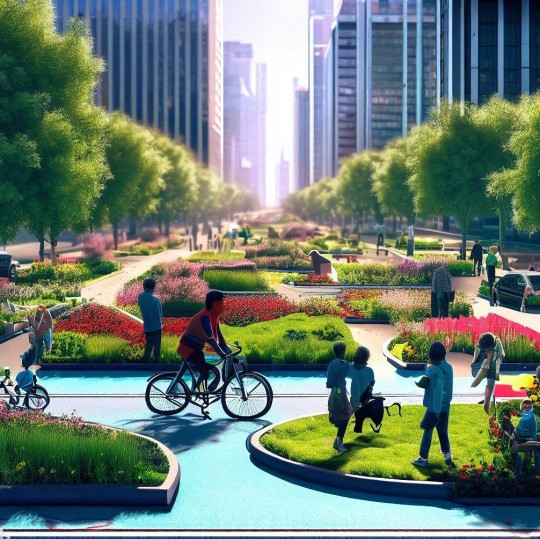
Among the benefits that trees bring to the urban environment, we can mention:
Trees perform ecological, social, and economic functions that contribute to the well-being and development of cities. They help to reduce air pollution by capturing particles, filtering harmful gases, and producing oxygen. Trees also absorb carbon from the atmosphere and store it in their wood, making them beneficial for climate change mitigation. Additionally, trees create shade, cool the air, and reduce energy consumption for cooling buildings. They prevent flooding, improve water quality, and increase biodiversity by providing shelter and food for many species. Trees enhance the urban landscape, mitigate noise, and even increase the value of properties.

Moreover, they promote physical and mental health by stimulating physical activity, reducing stress, and improving mood and concentration.
Therefore, roadside trees are a valuable resource for cities and their inhabitants. It is critical to protect, care for, and increase them through various means, such as public policies, private actions, and guaranteed maintenance over time, recognizing their fundamental role in the quality of urban life so that maintenance, which develops jobs, in particular, is 'guaranteed' over time,

Urban forestation and eco-neighborhoods.
Urban forestation refers to designing and creating green spaces in urban and peri-urban areas to incorporate nature into the landscape. It is important to both develop new green spaces and enhance existing ones.
Eco-neighborhoods serve as an example of sustainable and livable urban environments. They are designed considering the environment and the health of their residents. Sustainability principles are followed to improve the landscape and economic assets of the urban context. The design of an environmentally sustainable neighborhood aims to reduce its environmental impact during construction, throughout its life cycle, and even during decommissioning while prioritizing the comfort of its residents. These neighborhoods are built to improve people's quality of life by emphasizing energy conservation, renewable energy, environmentally friendly materials, reducing water and waste consumption, and promoting sustainable mobility. They are tangible parts of the city that contribute to the well-being of its inhabitants.
In addition, urban forestation is another example of how urban environments can be made more livable and sustainable. We can seamlessly blend nature into the urban landscape by integrating street trees, gardens, and parks. They represent elements of nature that help purify the air we breathe, capturing pollutants, storing carbon, and mitigating the climate of cities.
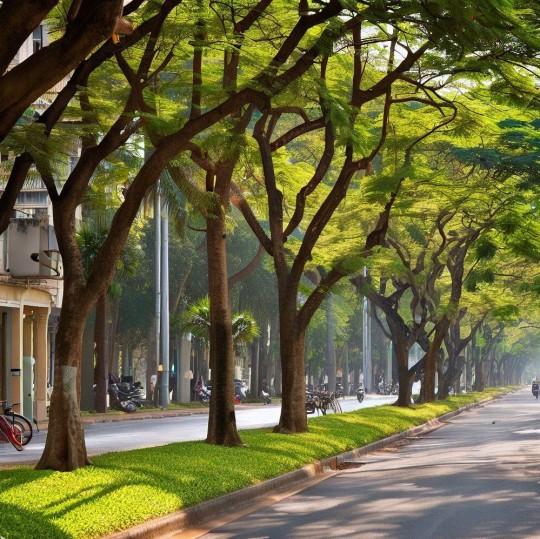
In summary, street-side trees are not just a decorative element but a proper green infrastructure that improves the quality of urban life. Therefore, It is vital to encourage planting, caring for, and preserving trees in urban areas, with the participation of government institutions, businesses, and residents, in order to achieve a shared vision to promote sustainable progress.
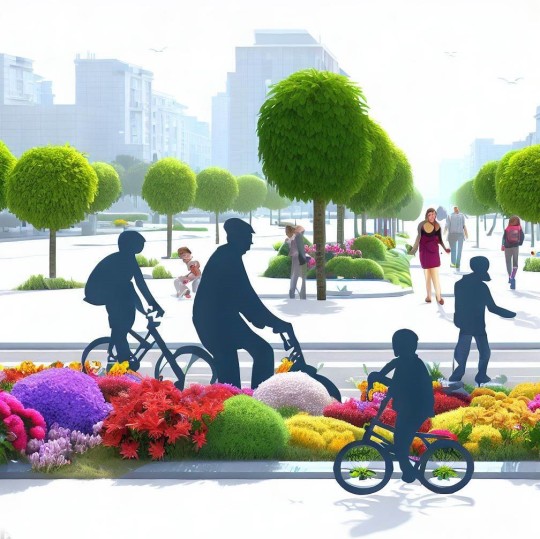
🟠 Italiano
Intro
Gli alberi sono elementi essenziali per creare paesaggi urbani attraenti e accoglienti, che favoriscono il benessere psicologico e sociale dei cittadini. contribuiscono a ridurre la temperatura e l'umidità dell'aria, mitigando gli effetti delle ondate di calore e del riscaldamento globale. Essi sono testimoni della storia, della cultura e dell'identità delle città, che conservano e trasmettono alle generazioni future. Alleati nella lotta ai cambiamenti climatici, oltre alla loro innegabile bellezza offrono una serie di benefici locali che spesso tendiamo a trascurare (al di là dei benefici globali di assorbimento dell’anidride carbonica). Questo articolo quindi ha lo scopo di sensibilizzare i lettori sull'importanza degli alberi per le città e per il pianeta, invitandoli a conoscere, apprezzare e tutelare il patrimonio arboreo urbano coinvolgendo i cittadini e le istituzioni in un processo partecipativo e responsabile.
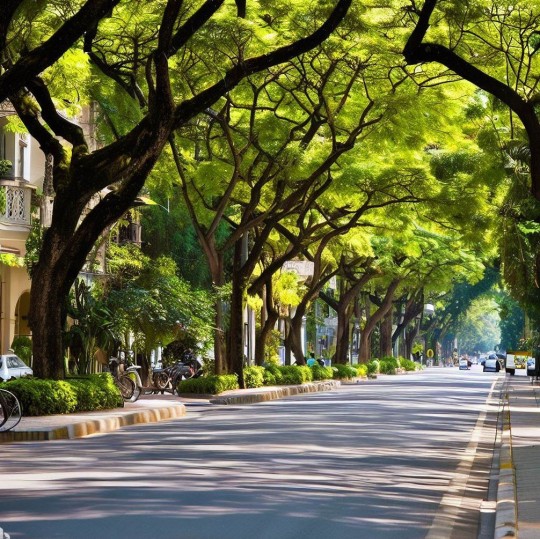
La magia degli alberi lungo le strade. Bellezza, frescura e prosperità urbana.
Gli alberi sono una risorsa preziosa per le città, non solo per il loro contributo alla mitigazione dei cambiamenti climatici, ma anche per i molteplici benefici che apportano alla salute, al benessere e alla qualità della vita dei cittadini. In questo articolo del Monocolo gli autori Paolo Massi e Giulia Papaleo, vogliono illustrare alcuni dei principali vantaggi che gli alberi offrono alle aree urbane e alle persone che le abitano. La magia degli alberi lungo le strade. Bellezza, frescura e prosperità urbana

La magia degli alberi lungo le strade dunque non si limita alla loro estetica. Gli alberi sono elementi essenziali per il benessere e lo sviluppo delle città, in quanto svolgono funzioni ecologiche, sociali ed economiche. Tra i vantaggi che gli alberi apportano all'ambiente urbano, possiamo citare:
Riduzione dell'inquinamento atmosferico: gli alberi catturano le particelle sospese nell'aria, filtrano i gas nocivi e producono ossigeno.
Mitigazione del cambiamento climatico: gli alberi assorbono il carbonio dall'atmosfera e lo immagazzinano nel loro legno, contribuendo a ridurre l'effetto serra.
Regolazione termica: gli alberi creano ombra e rinfrescano l'aria attraverso la traspirazione, diminuendo la temperatura e il consumo energetico per il raffreddamento degli edifici.
Conservazione del suolo e dell'acqua: gli alberi riducono l'erosione del suolo, aumentano la sua capacità di infiltrazione e ritardano il deflusso delle acque piovane, prevenendo le inondazioni e migliorando la qualità dell'acqua.
Incremento della biodiversità: gli alberi offrono rifugio e cibo a molte specie animali e vegetali, arricchendo la diversità biologica delle città.
Valorizzazione del paesaggio urbano: gli alberi creano scenari naturali, armonizzano l'architettura, attenuano il rumore e aumentano il valore immobiliare delle proprietà.
Promozione della salute e del benessere umano: gli alberi favoriscono la salute fisica e mentale delle persone, stimolando l'attività fisica, riducendo lo stress, migliorando l'umore e la concentrazione.
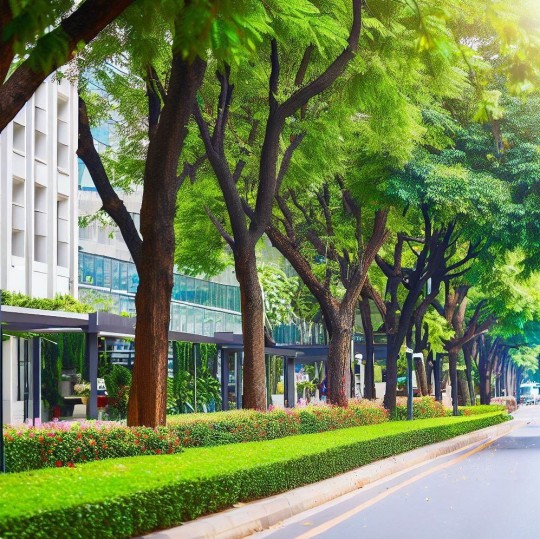
Gli alberi e le aiuole a verde lungo le strade sono quindi una risorsa preziosa per le città e i loro abitanti. Per questo motivo, è importante proteggerli, curarli e incrementarli, attraverso politiche pubbliche e azioni private che ne riconoscano il ruolo fondamentale per la qualità della vita urbana affinché la manutenzione, che sviluppa posti di lavoro, in particolare venga 'garantita' nel tempo.
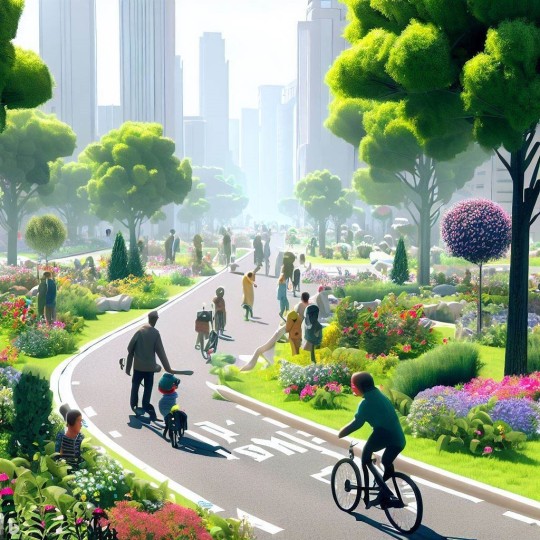
La forestazione urbana e gli ecoquartieri
Con il termine forestazione urbana si intende la progettazione e lo sviluppo di aree verdi urbane e periurbane, facendo della natura un'importante protagonista di questo paesaggio. Chiaramente è importante non solo progettare e sviluppare nuove aree verdi, ma anche rivalorizzare e riappropriarsi di quelle esistenti.
Certo! Gli ecoquartieri sono un esempio di ambienti urbani sostenibili e vivibili. Sono quartieri costruiti nel rispetto dell’equilibrio ambientale e della salute delle persone che vi abitano. Sono conformi ai principi della sostenibilità e puntano alla valorizzazione del patrimonio paesaggistico ed economico del contesto urbano in cui sono inseriti. La progettazione di un quartiere ecosostenibile punta a ridurne l’impatto ambientale: dalla fase di costruzione, al ciclo di vita, fino alla sua dismissione, senza mai dimenticare il comfort di chi lo vive. Si tratta di vere e proprie porzioni di città edificate con l’obiettivo di innalzare il livello di qualità della vita e sono realizzate ponendo l’accento su: risparmio energetico; uso delle energie rinnovabili e di materiale ecologico; riduzione del consumo di acqua e di rifiuti; promozione della mobilità sostenibile.
Inoltre, la forestazione urbana è un altro esempio di come gli ambienti urbani possono essere resi più vivibili e sostenibili. Le alberature stradali, i giardini e i parchi urbani rappresentano degli elementi di natura che contribuiscono a purificare l’aria che respiriamo, catturando sostanze inquinanti, immagazzinando carbonio e mitigando il clima delle città.
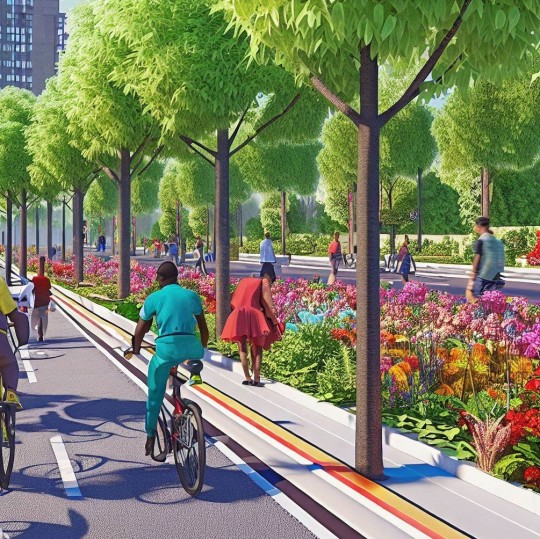
Come si può notare, gli alberi lungo le strade non sono solo un elemento decorativo, ma una vera e propria infrastruttura verde che migliora la qualità della vita urbana. Per questo motivo, è importante promuovere la piantumazione, la manutenzione e la protezione degli alberi nelle città, coinvolgendo le amministrazioni pubbliche, le imprese e i cittadini in una visione condivisa di sviluppo sostenibile.
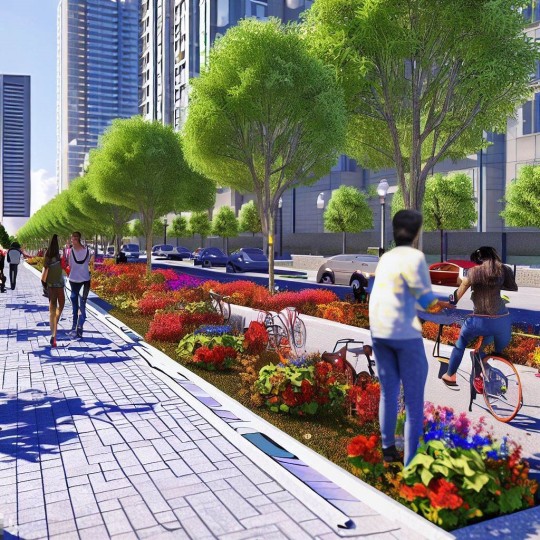
images created by The Board Behind © 2023
More related topics on this matter you might like:
Landscape Architecture: self-reflection on improving and enhancing our cities' run-down suburbs. English /Italian
Give color to the city to celebrate the joy of living.
I appreciate your kind presence and attention on this matter. Thank you for joining us today.
⏩ The Board Behind
#the board behind#sviluppo sostenibile#urban environments#urban tree heritage#ecological restoration#social growth#economic growth#city development#well being#urban living#urban life#heat wave#heat islands#sustainable progress#social innovation
15 notes
·
View notes
Note
Opinion on public transit
i was thinking during the day about my perfect commute from les arceaux to the place thermidor on the tram when i lived and worked in montpellier and the casino i'd get fresh bread from to go with plastic teacups of two euro shit wine, and i was thinking about the first bus driver who taught me how to load my bike onto a bike rack since i did not learn to drive until my mid-twenties and got around mainly that way, and the fact that my city built an elevated train system at the turn of the twentieth century and then TORE IT DOWN a few decades later and you can still see the ghost ruins of train platforms here and there, and about the seventh street divide...
however, my actual answer to this question is that i think we should abolish parking lots. i think the building of parking lots should be punishable by two decades community service, or death.
#peter answers#MY RAMEN IS READY BUT OHHHHHH THE URBAN HEAT ISLAND. THE DESCTRUCTION OF DOWNTOWN IN THE LATTER HALF OF THE 20TH CENTURY#AND DON'T EVEN GET ME STARTED ON UNION STATION
3 notes
·
View notes
Note
The first couple of times Silver went to the past it was coming from a fiery hellscape future, so he would've been somehow adapted to air with lots of smoke and several toxic gases. And since allergies tend to develop when you're never exposed to something, imagine the pollen allergies. Clear air but it's full of plant matter pfffffff
I like to think Silver joined the world of the past for real in late summer, when the pollen are less bad... so imagine his surprise when literally three-fourths of a year later, suddenly the very air around him is being all evil and attacking his airways for no reason. Scandalous! Outrageous!! Sonic meanwhile takes one look at his teary red eyes and running nose and comes back five minutes later with a hearty dose of antihistamines XD
Poor Silver would be even more miserable because he loves seeing the gorgeous flowers and new greenery after winter, so it's especially heinous that those are trying their hardest to keep him away through sheer bad luck. It's a good thing allergy medicine seems to be effective, so he can still enjoy everything in all its glory! But he quickly learns to always keep a package of tissues on his person, just in case he ends up in a bout of endless nose-blowing. And he might be just a little bit relieved when summer rolls around and the pollen become less bad!
#Sonic canonically has hay fever so he'd know how to deal with it#silver the hedgehog#I guess he'd do fine in a large city with lots of pollution then; at least when it comes to the lack of air quality lol#and he'd also know how to deal with urban heat islands during summer#clearly Silver is most capable of tackling the environmental causes and consequences of climate change
6 notes
·
View notes
Link
Excerpt from this story from The Revelator:
Extreme heat kills more people each year than any other type of weather-related event. Last year when the Biden administration launched a federal plan to address the problem, White House climate advisor Gina McCarthy called extreme heat a “silent killer.” Statistics show that annual heat-related deaths in the United States surpass mortalities from tornadoes, hurricanes, flooding, and cold winter weather combined, though the problem gets much less attention.
Those risks can be amplified in “heat islands” — urban areas where temperatures can be 10 or 20 degrees Fahrenheit hotter than in other parts of the same city. Disasters of our own design, they occur in places with few shade-supplying trees and a lot of buildings and pavement.
A growing body of research shows worldwide urban heat islands are predominantly located in low-income neighborhoods. In the United States, those neighborhoods are overwhelmingly home to people of color and immigrants.
Compounding matters, these same low-income areas tend to have higher percentages of people with medical conditions that make them particularly susceptible to heat-related illness.
Retrofitting solutions are good. But longer term, Jameel says, cities need to prioritize green space, not just more buildings.
Such urban-planning solutions are challenging in developing countries, he says, where new urban neighborhoods often spring up spontaneously, without formal planning.
7 notes
·
View notes